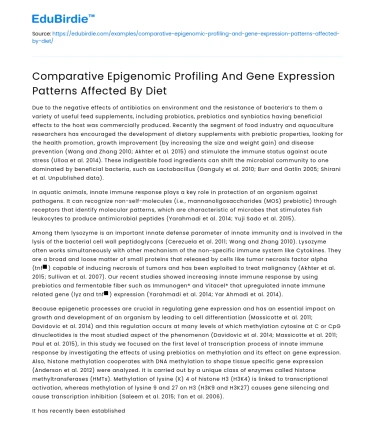Due to the negative effects of antibiotics on environment and the resistance of bacteria’s to them a variety of useful feed supplements, including probiotics, prebiotics and synbiotics having beneficial effects to the host was commercially produced. Recently the segment of food industry and aquaculture researchers has encouraged the development of dietary supplements with prebiotic properties, looking for the health promotion, growth improvement (by increasing the size and weight gain) and disease prevention (Wang and Zhang 2010; Akhter et al. 2015) and stimulate the immune status against acute stress (Ulloa et al. 2014). These indigestible food ingredients can shift the microbial community to one dominated by beneficial bacteria, such as Lactobacillus (Ganguly et al. 2010; Burr and Gatlin 2005; Shirani et al. Unpublished data).
In aquatic animals, innate immune response plays a key role in protection of an organism against pathogens. It can recognize non-self-molecules (i.e., mannanoligosaccharides (MOS) prebiotic) through receptors that identify molecular patterns, which are characteristic of microbes that stimulates fish leukocytes to produce antimicrobial peptides (Yarahmadi et al. 2014; Yuji Sado et al. 2015).
Save your time!
We can take care of your essay
- Proper editing and formatting
- Free revision, title page, and bibliography
- Flexible prices and money-back guarantee
Among them lysozyme is an important innate defense parameter of innate immunity and is involved in the lysis of the bacterial cell wall peptidoglycans (Cerezuela et al. 2011; Wang and Zhang 2010). Lysozyme often works simultaneously with other mechanism of the non-specific immune system like Cytokines. They are a broad and loose matter of small proteins that released by cells like tumor necrosis factor alpha (tnfα) capable of inducing necrosis of tumors and has been exploited to treat malignancy (Akhter et al. 2015; Sullivan et al. 2007). Our recent studies showed increasing innate immune response by using prebiotics and fermentable fiber such as Immunogen® and Vitacel® that upregulated innate immune related gene (lyz and tnfα) expression (Yarahmadi et al. 2014; Yar Ahmadi et al. 2014).
Because epigenetic processes are crucial in regulating gene expression and has an essential impact on growth and development of an organism by leading to cell differentiation (Massicotte et al. 2011; Davidovic et al. 2014) and this regulation occurs at many levels of which methylation cytosine at C or CpG dinucleotides is the most studied aspect of the phenomenon (Davidovic et al. 2014; Massicotte et al. 2011; Paul et al. 2015), in this study we focused on the first level of transcription process of innate immune response by investigating the effects of using prebiotics on methylation and its effect on gene expression. Also, histone methylation cooperates with DNA methylation to shape tissue specific gene expression (Anderson et al. 2012) were analyzed. It is carried out by a unique class of enzymes called histone methyltransferases (HMTs). Methylation of lysine (K) 4 of histone H3 (H3K4) is linked to transcriptional activation, whereas methylation of lysine 9 and 27 on H3 (H3K9 and H3K27) causes gene silencing and cause transcription inhibition (Saleem et al. 2015; Tan et al. 2006).
It has recently been established that epigenetic effects can be inherited from one generation to the next; therefore, the more was understood about epigenetic and how it modifies phenotype, the more accurately we may be able to program the development of the fish by tightly controlling various components of the environment (including the diet of the fish) at different stages of development because nutrition is one of the most important environmental signals affecting phenotype (Moghadam et al. 2015; Triantaphyllopoulos et al. 2016).
Since the zebrafish Danio rerio offers many advantages over other model systems including short 3-months life cycle, ease of manual experimentation, drug administration and its high fecundity (Trede et al. 2004; Postlethwait et al. 1994; Ulloa et al. 2014; Vaz et al. 2015) also it shares many of the same characteristics with numerous fish species of economic interest (Ribas and Piferrer 2013) it was selected for this study.
Although the effect of diet upon epigenetic parameters has rarely been assessed, nutritional genomics (Nutrigenomics) is a discipline that investigates the relationship between the genome of diets which studies how dietary ingredients affect the gene expression (Ulloa et al. 2014). To move one step forward and to find if the candidate immune response can be transferred to the next generation in this study we focused on evaluating the effect of dietary Agrimos® (a specific combination of MOS and β-glucans) on genetic (two candidate immune related (lyz & tnfα) genes expression) and epigenetic (DNA methylation and HMTs activity) changes of immature, mature and offspring of zebrafish (Danie rerio) as an animal model for high-throughput testing of experimental diets in aquaculture.






 Stuck on your essay?
Stuck on your essay?

